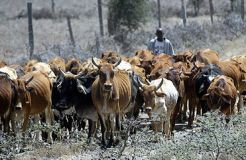Drought stokes fears of tribal conflict in northwest Kenya
Jan 29, 2006 (KAKUMA, Kenya ) — Jacob Lubuwin arrived in this dusty town in northwest Kenya town with his small livestock herd two months ago when the scorching drought that now threatens millions across east Africa first began bite.
 No stranger to the harsh, semi-arid conditions of the region, the 33-year-old Turkana tribesman often makes the two-day trek here from his remote village on the Ugandan border in search of water and fodder for his sheep, goats and cattle and to sell them, but this year is the bleakest in memory.
No stranger to the harsh, semi-arid conditions of the region, the 33-year-old Turkana tribesman often makes the two-day trek here from his remote village on the Ugandan border in search of water and fodder for his sheep, goats and cattle and to sell them, but this year is the bleakest in memory.
Hunger and thirst have killed more than half of his 60 animals, depriving him of critical income, and he has enough money to feed the remaining 27 in his flock and his family for only another 10 days.
“Some years, I lose a couple of animals, but never this many,” Lubuwin says despairingly. “Even when my animals die we can’t eat them because they are too skinny, there is no meat and they are unhealthy. I’m only left for God to decide what will happen.”
As the drought continues with no end in site and rising human and animal mortality, Kenya’s livestock-dependent pastoralists, like Lubuwin’s Turkana, are roaming ever greater distances in search of water and pasture, often encroaching on territory claimed by rival clans and sparking violence.
“When there is drought they move from their land to another clan’s lands,” said Eric Mgendi, an official with the relief group ActionAid International which does work in the region. “Tribal conflict in Kenya’s northwest region is very likely if this continues.”
Already, there have been horrifying clashes.
Earlier this month, at least 38 people were killed in remote northwestern border town when cattle-raiding tribes from neighboring Sudan and Ethiopia attacked two Turkana villages, in what local officials said was a direct result of drought-related land encroachment.
“Pastoralists are forced to walk some distance looking for water and fodder,” said Cosmas Chanda of the UN High Commissioner for Refugees (UNHCR) who runs a camp in Kakuma for displaced Sudanese. “They often encounter different tribes from Sudan and Ethiopia and there is often hostility and tension.
“The repercussions of this drought are quite devastating,” he said, adding that the movement of the pastoralists has also created friction with their more urbanized cousins, even from the same tribe.
Residents of small towns like Kakuma, population 50,000, are now forced to compete with a steady stream of pastoralists seeking relief from the drought, swelling the population well beyond the capacity of the town’s resources.
“This year … we are seeing more pastoralists in town than we ever have,” said Peter Emuria, 30, a lifelong Kakuma resident. “They are using up the little water and pasture we have.”
Making matters stickier, the town is home to Kenya’s second-largest refugee camp which supplies water to more than 90,000 refugees.
With the number of people in the area in need of food and water poised to double with the influx of pastoralists looking for relief, Chanda fears trouble between the refugees at his camp and locals.
“Most are relying on the same fodder and water for their livestock,” he said. “There could be tensions between them if they rely on the same scarce resources.”
Another complication is that although northwest Kenya is considered part of the drought emergency, which the government says threatens at least 3.5 million people, its perennial poor rains and desert-like climate plus the presence of the UN camp have left it low on the list relief priorities.
Aid workers complain that despite evidence of malnutrition and dying livestock in the northwest, more attention is being paid to the northeast and coastal regions, where at least 40 people have died of drought-related malnutrition and associated illness since December.
“The biggest assumption is that there is a large UN presence in the area and therefore, the government does not need to concentrate on these areas,” said Mgendi of ActionAid. “It is a gross assumption.”
(ST/AFP)
